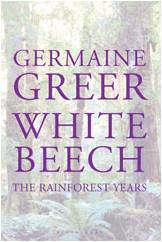by Germaine Greer
Bloomsbury
In December 2001, at the age of 62, Germaine Greer wondered how much longer she could earn a living from her pen and her tongue. When all her friends were buying units on the Sunshine Coast, she bought sixty hectares of steep, rocky rainforest in the Gold Coast Hinterland of south east Queensland. The former dairy farm was covered with acres of exotic grasses, weeds, impenetrable scrub and curtains of tangled lantana and Greer wanted to heal a part of the earth where she was from. Even though she never regarded the forest as actually belonging to her, she saw it as her chance to “clean up something, sort something out, make it right”. After spending 10 years proving that the devastation of Australia’s biodiversity could be reversed, she decided to write this book “to convey the deep joy that rebuilding wild nature can bring.
It was a huge task. Cave Creek rainforest trees weren’t readily available in garden centres. They rescued a white beech tree that was being suffocated by lantana, harvested the seeds and successfully germinated them. With the help of her younger sister Jane who is a botanist and local botanist David Jinks, she discovered many rare and endangered plants on the property. Evidently half of Australia’s grasses are classified as weeds because of their effect on pasture. Along the way, Greer’s acid tongue and infectious language take swipes at many things including the exploitation and desecration of Australia’s land, National Parks, Eco Tourism and conservation (or lack of) in Australia.
Forever the academic, Greer searches for information on the traditional owners and digs up massacres and exploitation by timber fellers and farmers. Her book has chapters on the plants, insects and animals of the area and she shares her joy at the discoveries she made. “Whenever a truly wild creature lets me see it behaving naturally, I feel a blessedness, as if I have been allowed to enter a realm far more special than the celebrity A-list.” Although this a well-documented journey sometimes reads like a PHD thesis, it is thorough and interesting and Friends of Gondwana Rainforest have now taken over the task.
Lezly Herbert







